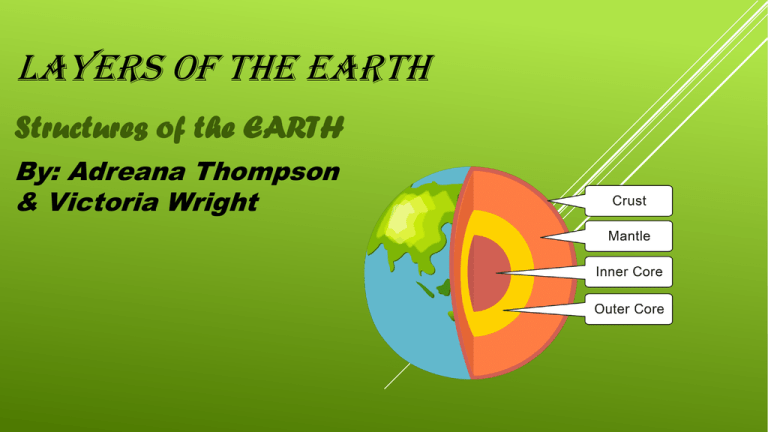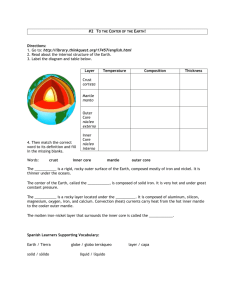Layers Of the earth
advertisement

LAYERS OF THE EARTH Structures of the EARTH By: Adreana Thompson & Victoria Wright CRUST • the outermost solid shell of a rocky planet or natural satellite The crust amounts to less than half of 1 percent of the planet. The crust can be thicker than 80 kilometers in some spots, less than one kilometer in others. The crust is primarily made of granite and basalt while the mantle beneath is made of peridotite. MANTLE • The region of the interior of the Earth between the core (on its inner surface) and the crust (on its outer). Note: The mantle is more than two thousand miles thick and accounts for more than three-quarters of the volume of the Earth. *The Mantle is the second layer of the Earth. • * It is the biggest and takes up 84 percent of the Earth. • *The mantle is divided into two sections. • * The Asthenosphere, the bottom layer of the mantle made of plastic like fluid and The Lithosphere the top part of the mantle made of a cold dense rock. OUTER CORE • The internal structure of Earth. This is a liquid layer about 2,300 km thick and composed of iron and nickel that lies above Earth's solid inner core and below its mantle. Its outer boundary lies 2,890 km beneath the Earth's surface • *The Outer Core is the second to last layer of the Earth. • * The outer is a magma like liquid layer that surrounds the Inner Core and creates Earth's magnetic field. • * The Outer Core is about 2200 km thick. • *It is the second largest layer and made entirely out of liquid magma. INNER CORE The earths innermost part and is a primarily solid ball about 1200 kilometers. *The Inner Core is the final layer of the Earth. *The core is a solid ball made of metal. *The inner-most core makes up 19 percent of the Earth's total volume, which makes it just 30 percent smaller than the moon. FROM THE INSIDE, OUT! Inner-core Outer-core Metallic Liquid. Solid. Stabilizes the magnetic field created by outer core. Temperature as high as 9,000° F. Creates Earths magnetic fields through convection currents and the Coriolis effects. Temperatures range from 4,000 to 9,000° F. Depth ranges from about 1,800 to 3,200 miles. Depth ranges from about 3,200 to 3,900 miles. HOW ARE THEY DIFFERENT? Crust The crust consists of plates, both oceanic and continental, which are in continuous motion. Thinnest part of the earth. The thin oceanic crust is composed of basalt and the thicker continental crust is composed primarily of granite. Mantle The mantle is liquid, so it allows the crusts to move, causing long term continental movements, and in the short term earthquakes and volcanoes. Thickest part of the earth. Earth's mantle is mainly made up of olivine-rich rock. ~ *REVIEW* ~ The Earth's interior is composed of four layers, three solid and one liquid, not magma but molten metal, nearly as hot as the surface of the sun. The deepest layer is a solid iron ball, about 1,500 miles in diameter. Above the inner core is the outer core, a shell of liquid iron, this layer is cooler but still very hot, anywhere from 7,200 to 9,000 degrees Fahrenheit. (composed mostly of iron.) The next layer is mantle, many people think it’s lava, but it's actually rock. The crust is the outermost layer of the Earth. It is the familiar landscape on which we live: rocks, soil, and seabed. It ranges from about five miles thick beneath the oceans to an average of about 25 miles thick way beneath the continents. The interior of the Earth cannot be studied by drilling holes to take samples. Instead, scientists map the interior by watching how seismic waves from earthquakes are bent, reflected, or delayed by the various layers.






